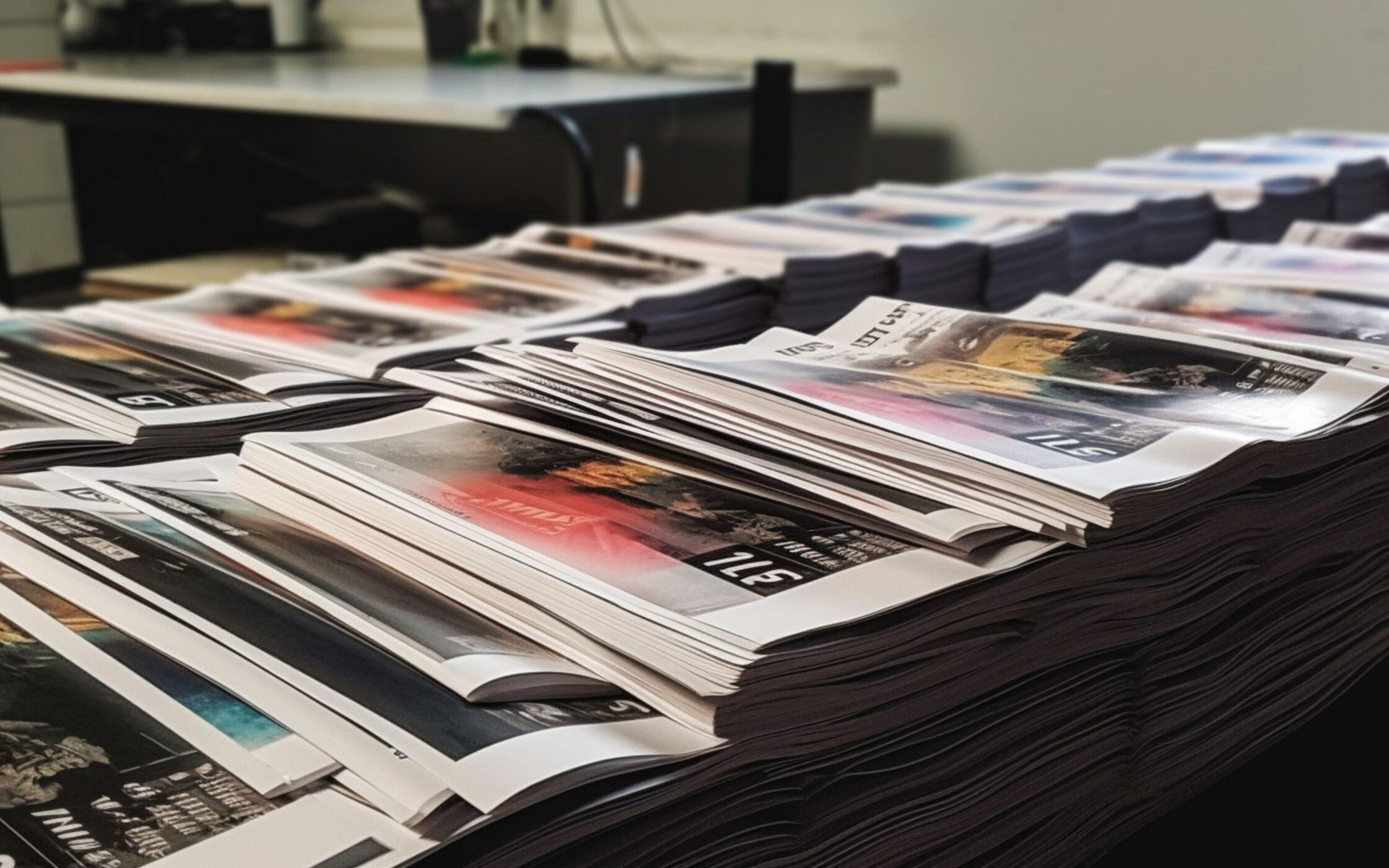Navigating the Tides of Change: Print Media in the Digital Era
In an era where swiping on screens has become second nature, the allure of flipping through the crisp pages of a newspaper or magazine seems almost nostalgic. Remember the last time you held a physical newspaper? If you're struggling to recall, you're not alone. The decline of print media is a topic that has been under the microscope for years, yet it remains more relevant than ever as we navigate through the digital age.
Imagine a world where the morning ritual of sipping coffee while scanning the headlines of your favourite newspaper is replaced by scrolling through an endless feed of articles on a glaring screen. Sounds disheartening, doesn't it? But is it inevitable?
In this comprehensive exploration, we'll delve into the fascinating journey of print media from its golden days to its current state of decline. We'll weigh the pros and cons of both print and digital media, backed by compelling statistics and real-world case studies. Whether you're a digital native who's never picked up a newspaper or a print aficionado clinging to the tactile experience of a paperback, this article promises to offer you valuable insights into the future of media consumption.
By the end of this read, you'll have a clearer understanding of whether digital platforms can ever truly replicate the unique qualities that make print media so special. So, let's turn the page—or should we say, scroll down—and dive right in.
Historical Context
The Golden Age of Print Media
Long before the advent of the internet, print media was the cornerstone of information dissemination and public discourse. From the first printing press invented by Johannes Gutenberg in the 15th century to the proliferation of newspapers, magazines, and journals, print media has a storied history that has shaped societies and fuelled revolutions. It was through the ink-stained pages of newspapers that people learned about world events, scientific discoveries, and cultural milestones. The tactile experience of flipping through a magazine or unfolding a broadsheet newspaper became rituals deeply ingrained in our daily lives.
In the 20th century, print media reached its zenith. Newspapers like The New York Times, The Guardian, and local publications became trusted sources of information. Magazines catered to niche interests, from fashion and lifestyle to science and technology. The print industry not only informed but also employed thousands, from journalists and editors to printers and distributors.
The Digital Disruption
Enter the digital age. The late '90s and early 2000s marked a seismic shift in how we consume information. The internet became a household necessity, and with it came the rise of digital media platforms. News websites, blogs, and social media channels began to sprout like mushrooms after a rainstorm, offering instant access to a plethora of information at the click of a mouse or a tap on a screen.
Initially, digital media coexisted with print as an alternative, often replicating the same articles online. However, as technology advanced, the scales began to tip. The introduction of smartphones and tablets made digital media not just an alternative but a more convenient option. Why wait for the morning paper when breaking news could be delivered to your pocket in real-time?
The convenience of digital media, coupled with its lower production costs and broader reach, began to overshadow print. Publications started to see a decline in print subscriptions and advertising revenue, forcing many to either shut down their print operations or transition to a digital-first strategy.
The Tipping Point
Today, we find ourselves at a tipping point. While print media hasn't disappeared entirely, its role has diminished significantly. Digital platforms offer interactive experiences, multimedia storytelling, and real-time updates, features that print simply can't match. Yet, the question remains: Can digital ever truly replace the essence of print media?
The Decline of Print Media
By the Numbers: The Statistical Reality
The decline of print media is more than just a perception; it's backed by hard-hitting statistics. According to a Pew Research Centre study, U.S. newspaper circulation fell to its lowest level since 1940, with a decline of about 8% in 2020 alone. Advertising revenue, the lifeblood of print media, has also seen a staggering drop. In the last decade, print ad revenue has plummeted by over 60%, making it increasingly difficult for publications to sustain their operations.
Case Studies: The Fall of Giants
The statistics are not just numbers on a screen; they manifest in the real world through the decline or closure of iconic publications. Take, for example, the case of the Village Voice, a New York-based alternative weekly that ceased its print operations in 2017 after six decades. Or consider the fate of Newsweek, which transitioned to an online-only format in 2013 before making a limited return to print. These are not isolated incidents but rather symptomatic of a larger trend affecting both national and local publications.
The Domino Effect: Impact on Journalism, Advertising, and Local News
The decline of print media has a ripple effect that extends beyond just the publications themselves.
-
Journalism: The shift to digital has led to the rise of "clickbait" journalism, where the emphasis is often on quantity over quality. Investigative journalism, which requires time and resources, is becoming a rarity as newsrooms face budget cuts and layoffs.
-
Advertising: The decline in print has also impacted the advertising industry. Brands are reallocating their budgets to digital platforms, which offer more targeted and measurable results. However, the saturation of digital ads has led to phenomena like "banner blindness," where consumers ignore online ads, questioning the effectiveness of digital advertising.
-
Local News: Perhaps the most significant casualty of the decline in print media is local news. Local newspapers are often the only source of community-specific information, and their decline leaves a void that social media and national news outlets can't fill. This has implications for local governance, community engagement, and even democracy itself.
The Rise of Digital Media
Advantages Over Print: The Digital Edge
Digital media has several distinct advantages over its print counterpart, which have contributed to its rapid rise.
-
Instant Access: In a world where information changes by the minute, the ability to update content in real-time is invaluable. No need to wait for the next day's paper; news is available at your fingertips instantly.
-
Interactivity: Digital platforms offer an interactive experience, from embedded videos and hyperlinks to comment sections and social sharing features, enriching the user's engagement with the content.
-
Global Reach: Unlike print media, which is often confined to geographical boundaries, digital media has a global reach. A blog post or news article can be accessed and shared by people worldwide, amplifying its impact.
-
Cost-Effectiveness: Digital media eliminates the costs of printing and distribution, making it a more economical option for both publishers and consumers.
The Numbers Game: Digital Media Consumption Stats
The shift towards digital media is not just anecdotal; it's supported by compelling statistics. According to a report by eMarketer, adults in the U.S. spent an average of 3 hours and 35 minutes per day on mobile devices in 2020, a 20-minute increase from the previous year. Furthermore, global digital ad spending reached $333.25 billion in 2020, surpassing traditional advertising for the first time.
Innovations in Information Dissemination
Digital media has revolutionized the way information is disseminated and consumed. Here are some key innovations:
-
Personalization Algorithms: Platforms like Google News and social media feeds use algorithms to curate content based on user behaviour, offering a personalized reading experience.
-
Multimedia Storytelling: The digital format allows for a richer narrative, incorporating videos, podcasts, and interactive infographics, which can make complex topics more accessible and engaging.
-
Social Media as a News Source: Platforms like Twitter and Facebook have become vital sources of real-time information, often breaking news before traditional outlets. However, this also raises concerns about the accuracy and reliability of such information.
Reflecting on Reader Insights: The Unsung Benefits of Digital Media
We recently received a thought-provoking email from Cameron Finley, a reader from Lindsay, Ontario, Canada, which shed light on some crucial points that we hadn't fully explored in our initial analysis. Cameron's perspective offers additional insights into why the shift towards digital media isn't just a matter of convenience or trend, but also a step towards a more sustainable and practical future.
Environmental Impact: Often sidelined in discussions, the environmental advantages of digital media are profoundly significant. The transition from print to digital media marks a dramatic decrease in paper usage, leading to a consequential reduction in tree felling. This change is not just about saving trees; it's a pivotal component of our collective endeavour to preserve natural resources and combat the dire effects of climate change. By embracing digital media, we're not merely adapting to a digital age; we're actively participating in the safeguarding of our planet for future generations.
Reducing Physical Waste: In tandem with the environmental benefits, digital media plays a substantial role in diminishing physical waste. The absence of a need for tangible copies of newspapers, magazines, and books means significantly less paper waste. This reduction is a stride towards a cleaner, more sustainable planet. When we choose digital over print, we're not just opting for convenience; we're contributing to a larger movement of environmental consciousness and responsible consumption.
Convenience and Cleanliness: Cameron didn't stop at environmental benefits; he also highlighted the practical advantages of digital media. Remember the days when reading a newspaper left your hands stained with ink? Digital media eliminates this messy inconvenience. Moreover, it offers the distinct benefit of adjustable text size and font, a boon for inclusivity and accessibility. This feature is particularly advantageous for individuals with visual impairments, ensuring that reading remains a joy accessible to all, unhindered by physical limitations.
Your Thoughts?
"Cameron's insights have enriched our dialogue on the future of print and digital media, introducing facets we had not considered before. What are your thoughts on these points? Do you reckon these environmental and practical benefits suffice to replace the tactile pleasure and nostalgia tied to print media? We invite you to share your views and experiences in the comments section below. Your perspective is invaluable to us, and we're eager to engage in this ongoing conversation!"
The Digital Dilemma: Local News Media in Transition
A recent conversation with one of our readers, Cam from Ontario, Canada, brought to light a critical issue in the media landscape - the struggle of local news outlets amidst the digital revolution. While we've extensively discussed the broader shift from print to digital, the specific challenges faced by local news sources deserve a closer examination.
The Plight of Local Journalism: In many small towns and cities, local newspapers have long been the lifeblood of community journalism, offering a unique and indispensable perspective on local events, issues, and stories. However, the digital transition has not been kind to these publications. In Ontario alone, the closure of numerous local newspapers has led to over 600 job losses, a staggering blow to the industry. The harsh reality is that many of these outlets lacked the resources to sustain digital versions of their publications.
The Gap in Local Coverage: These closures highlight a significant gap in the digital news landscape. Local newspapers often serve as the primary, if not the only, source of detailed local news. Their decline means communities lose a vital connection to their local identity and happenings. This gap poses the question: How can digital media adapt to serve local communities effectively?
Understanding the Challenges: The transition for local news from print to digital is fraught with financial and logistical hurdles. Unlike larger publications with broader audiences, local news sources often rely heavily on local advertising revenues, which can be hard to replicate in a digital format. Additionally, the intimate nature of local news requires a deep understanding of the community, something that larger digital platforms often cannot replicate.
Seeking Solutions: It's imperative to explore how digital media can evolve to support and sustain local journalism. Could new business models, community funding initiatives, or innovative digital platforms offer a lifeline? How can technology be leveraged to enhance, rather than replace, the role of local news in our communities?
Your Voice Matters: As we grapple with these questions, we invite you, our readers, to share your thoughts. How has the decline in local print media affected your community? What solutions or innovations do you envision for local news in the digital age? Your insights are crucial as we navigate this complex transition.
A Note on Job Losses: It's important to note that our discussion on the impact of digital media on local news is grounded in real, tangible events. As reported by CBC, the transition's challenges were starkly highlighted when Metroland Media Group in Ontario declared bankruptcy, leading to the layoffs of 600 individuals, including 68 journalists. This fact underscores the profound effect that the decline of print media can have on local communities and economies
Can Digital Replace Print?
The Tactile Experience: More Than Just Words on a Page
There's something inherently satisfying about the tactile experience of print media. The rustle of pages turning, the texture of the paper, and even the smell of ink contribute to a sensory experience that digital platforms can't replicate. Whether it's the Sunday newspaper spread across the breakfast table or the dog-eared pages of a beloved novel, print offers a physicality that engages more than just our sense of sight. It's an immersive experience that many argue adds a layer of depth and enjoyment to the content, making it more memorable and impactful.
Credibility and Trust: The Print Legacy
Print media has long been considered a reliable source of information. The rigorous editorial standards, fact-checking processes, and the very permanence of print lend it a level of credibility that digital media often struggles to match. In a digital landscape rife with fake news, clickbait, and fleeting viral trends, the trustworthiness of print becomes an invaluable asset. While digital platforms are making strides in enhancing credibility through verification processes and improved editorial standards, the legacy of trust built by print media over centuries is not easily overshadowed.
Digital Fatigue: The Strain of Screen Time
As we spend increasing amounts of time staring at screens, the phenomenon of digital fatigue becomes a growing concern. The glare of digital devices can lead to eye strain, headaches, and even disrupted sleep. Moreover, the endless scroll of digital content can be overwhelming, leading to reduced attention spans and information overload. In contrast, print media offers a break from screen time, allowing for focused, deep reading without the distractions of notifications, pop-up ads, and hyperlinks.
The Missing Sensory Experience
While digital media offers convenience and interactivity, it lacks the sensory richness of print. The feel of high-quality paper, the visual appeal of well-designed layouts, and even the smell of a freshly printed magazine create a multi-sensory experience that digital formats can't provide. This sensory engagement not only enhances the joy of reading but also aids in memory retention and comprehension.
Pros and Cons: A Side-by-Side Comparison
In the ongoing debate between print and digital media, it's crucial to consider the pros and cons of each medium across different dimensions. Let's break it down:
Accessibility
Print: The reach of print media is inherently tied to its physical nature. Accessibility is limited to areas where it's distributed, and once out of print, obtaining past editions can be challenging. This physicality, though, adds a sense of exclusivity and permanence to the content.
Digital: Digital media breaks geographical barriers, offering global access anytime, provided there's an internet connection. Its archival capabilities allow for easy retrieval of past content, significantly expanding its accessibility and convenience.
Cost
Print: Producing print media involves substantial costs related to materials (like paper and ink) and logistics (including printing and distribution). These expenses often translate to higher consumer prices, particularly for niche or specialised publications.
Digital: The lower production costs of digital media, devoid of physical material expenses, usually result in more affordable or even free access to content. However, the growing trend of paywalls on news websites introduces a paid model for premium digital content, balancing the need for revenue against free access.
Engagement
Print: Print media offers a tactile experience that can lead to heightened engagement and better information retention. The physical act of turning pages can create a more immersive experience. However, it lacks the interactive elements that digital media provides.
Digital: The interactivity of digital media, encompassing hyperlinks, comments, and multimedia, fosters a dynamic and engaging user experience. But this comes with the downside of potential distractions, such as advertisements and pop-up notifications, which can disrupt the reading experience.
Environmental Impact
Print: The ecological footprint of print media is substantial. It encompasses the cutting down of trees for paper, the energy consumed in printing, and emissions from distribution. Recycling efforts help, but they don't completely offset the environmental toll.
Digital: Digital media's environmental impact is less visible but still significant, mainly due to the energy consumption of data centres and devices. While digital's ecological footprint is typically lower than print's, concerns about electronic waste and energy use in the digital infrastructure are growing topics in environmental discussions.
Case Studies: Finding the Sweet Spot Between Print and Digital
In the ever-changing landscape of media, some companies and publications have managed to adapt and thrive. Let's delve into a few case studies that showcase successful transitions from print to digital, as well as those that have found a harmonious balance between the two.
The New York Times: A Digital Transformation
The New York Times, one of the most respected newspapers globally, has successfully transitioned into the digital age. Faced with declining print subscriptions and ad revenues, the publication invested heavily in its digital platforms. Today, it boasts over 7 million digital-only subscribers and has diversified its online offerings to include podcasts, interactive articles, and even virtual events. The New York Times serves as a prime example of how a traditional print publication can reinvent itself in the digital era without compromising its journalistic integrity.
National Geographic: Striking a Balance
National Geographic has managed to find a balance between its iconic print magazine and its digital platforms. While the print magazine continues to be a collector's item with its stunning photography and in-depth articles, the brand has also embraced digital media with a robust website, mobile apps, and a strong social media presence. Their digital platforms offer interactive features like videos and quizzes, attracting a younger audience without alienating their traditional print readership.
The Guardian: Embracing a Digital-First Strategy
The Guardian newspaper in the UK faced significant financial challenges due to declining print sales. However, they successfully pivoted to a digital-first strategy, focusing on online content and even asking readers for donations. This approach has not only helped them maintain their journalistic standards but also turned them into one of the most-read news websites globally. Importantly, they've managed this transition while keeping their print edition alive for a more traditional audience.
Local Newspapers: The Importance of Community
While many local newspapers have struggled with the digital transition, some have found success by focusing on community engagement. Publications like the Texas Tribune have adopted a digital-first approach but also produce print editions for local events and special occasions. By leveraging their community ties, these local papers have managed to survive and even thrive in the digital age.
The Future: Where Are Print and Digital Media Headed?
As we navigate through this transitional period in media consumption, it's essential to look ahead and consider what the future holds for both print and digital media. Here are some emerging trends and expert opinions that offer a glimpse into what's on the horizon.
Emerging Trends
-
Print on Demand: One of the most promising trends in print media is the rise of print-on-demand services. This model allows for more targeted, less wasteful printing, catering to a niche audience who still values the tactile experience of print.
-
Augmented Reality in Print: Publications are experimenting with integrating Augmented Reality (AR) into print media, offering an interactive experience that bridges the gap between print and digital.
-
Digital Subscriptions and Paywalls: As ad revenues decline, more digital publications are moving towards subscription models and paywalls, focusing on quality over quantity.
-
AI and Personalization: Artificial Intelligence is playing an increasingly significant role in curating personalized digital content, enhancing user engagement and retention.
-
Voice Search and Smart Speakers: The rise of voice search and smart speakers like Amazon's Alexa and Google Home is changing how people access digital content, making it more accessible and integrated into daily life.
Expert Opinions
-
The Resurgence of Print: According to Mark Thompson, former CEO of The New York Times, there's a "resurgence in the willingness to pay for quality print journalism." He believes that while print may become more niche, it will continue to hold value for a specific audience.
-
The Importance of Trust: Edelman's Trust Barometer report highlights that trust is becoming a more critical factor in media consumption. This could work in favour of established print publications that are generally viewed as more reliable.
-
The Digital Saturation Point: Experts like Emily Bell, Director at the Tow Centre for Digital Journalism, argue that we may be reaching a saturation point for digital content. As people experience digital fatigue, there may be a renewed interest in print as a 'digital detox' option.
Conclusion
As we've journeyed through the complex landscape of print and digital media, several key points emerge. Print media, with its tactile experience and legacy of trust, offers something that digital platforms have yet to fully replicate. On the flip side, digital media provides unparalleled accessibility, interactivity, and convenience, making it the go-to choice for many in our fast-paced world.
Both mediums have their pros and cons, from cost and engagement to environmental impact. While some publications have successfully transitioned to digital or found a balance between the two, the future remains uncertain. Emerging trends like print-on-demand, augmented reality, and digital personalization are shaping the way we consume content, and the most successful players will be those who adapt to these changing tides.
Final Thought: As we stand at this crossroads, one question looms large: Will there ever be a clear winner in the print vs. digital debate, or are we moving towards a future where each has its own specialized role to play?
We'd love to hear your thoughts on this ever-relevant topic. Do you have a preference for print or digital? Have you noticed your own habits changing over time? Share your insights in the comments section below.
If you found this article informative and thought-provoking, please consider sharing it on your social media platforms. For more in-depth discussions on topics that matter, don't forget to subscribe to our blog.
Let's continue this conversation and explore the future of media together!








Comments (0)
Add a Comment